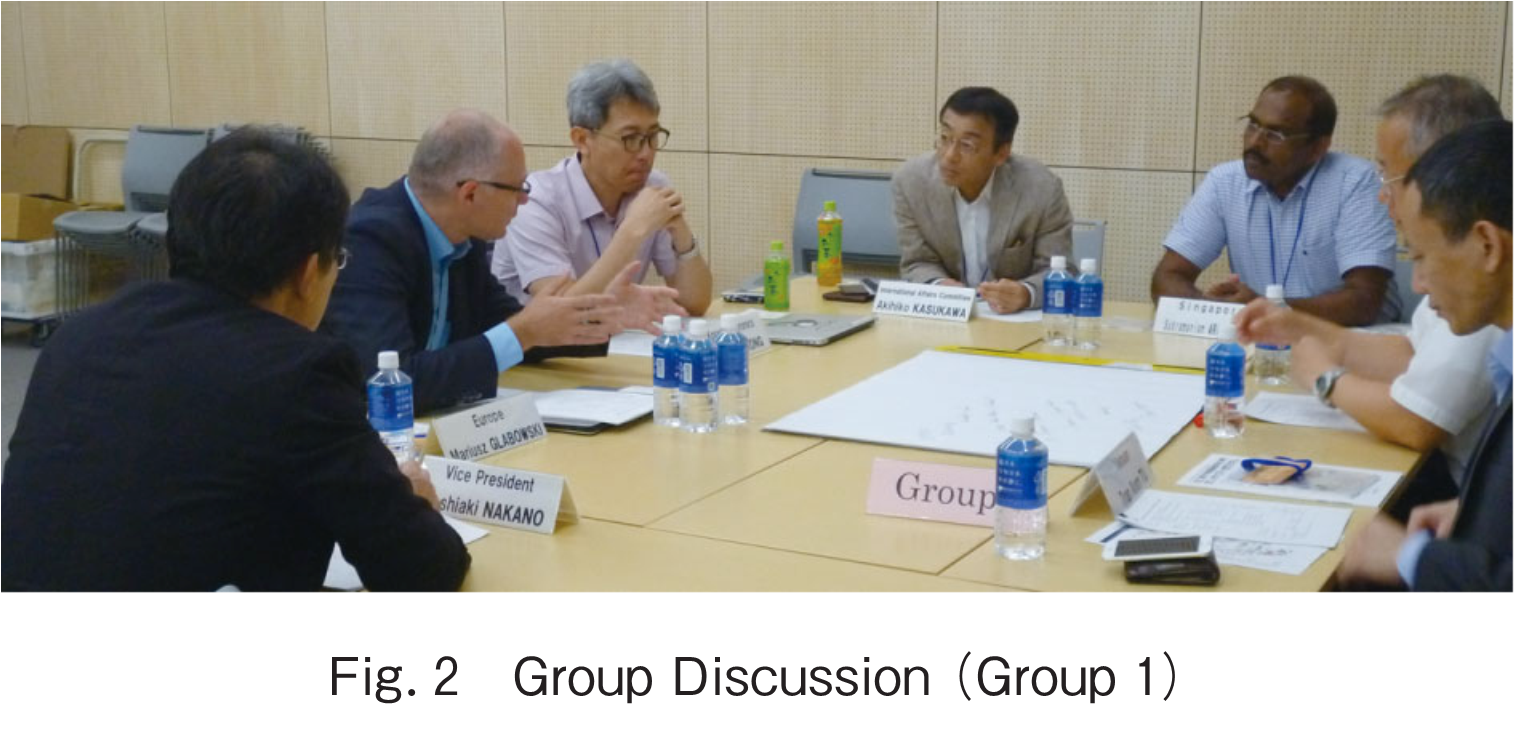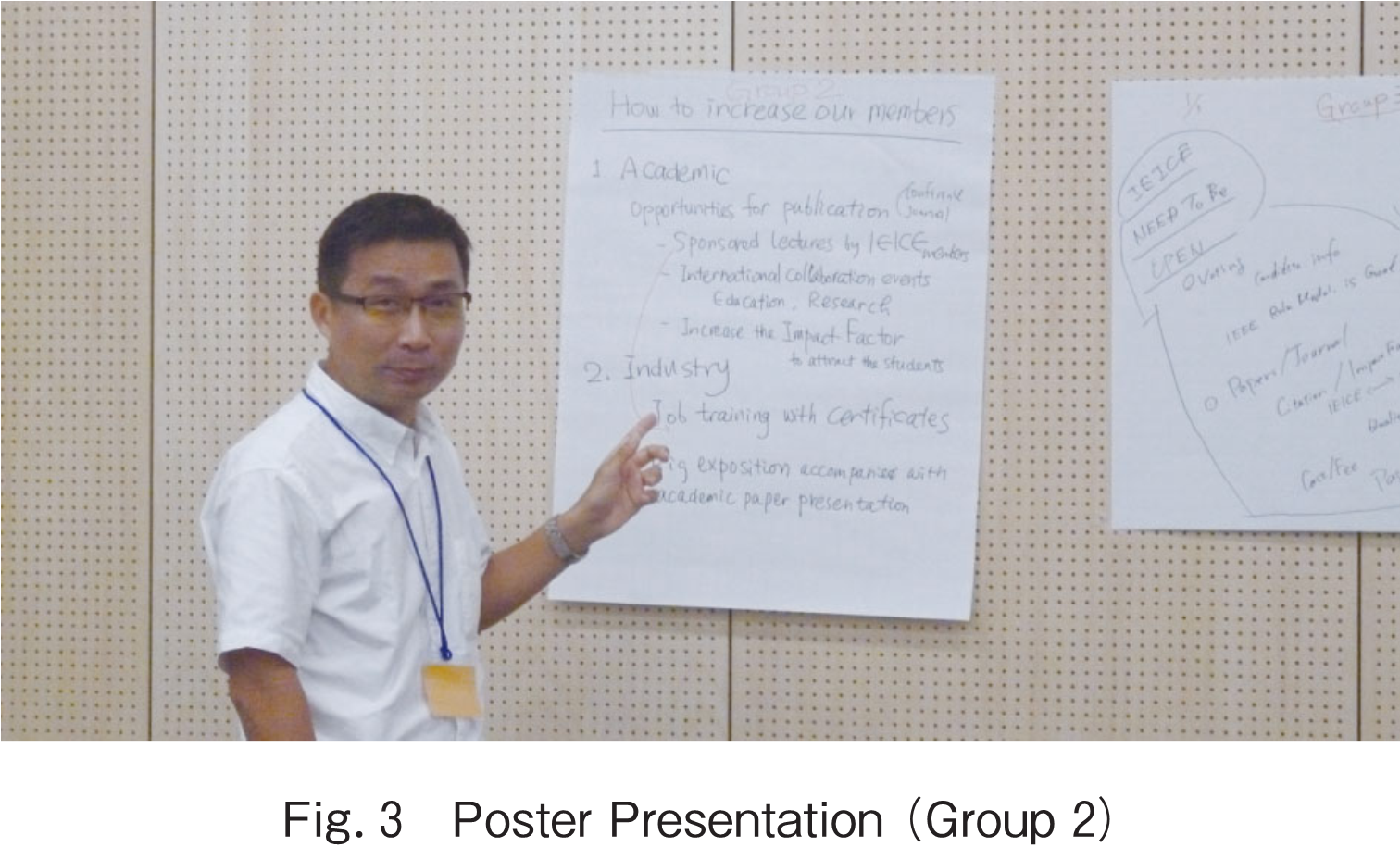
|
電子情報通信学会 - IEICE会誌 試し読みサイト
© Copyright IEICE. All rights reserved.
|

|
電子情報通信学会 - IEICE会誌 試し読みサイト
© Copyright IEICE. All rights reserved.
|

abstract
To facilitate the international activities, IEICE regularly organizes the All Sections Meeting (ASM) in the occasion of Spring or Autumn Conferences of IEICE. This article reports the summary of ASM held on September 13, 2017. In particular, the results of the group discussion within ASM under the main theme “What should IEICE do as an international academic society?” are emphasized in this article.
Keywords:International Sections, International Affairs Committee, All Sections Meeting, International Members
As explained in (Ref.(1)), IEICE has twelve International Sections in Asia and Europe at present. The representatives of these Sections are invited to All Sections meeting (ASM) which are organized every 18-month during the General or Society Conference of IEICE by International Affairs Committee (IAC).
This article reports the most recent meeting taken place on September 13, 2017 in Tokyo City University, the venue of IEICE Society Conference. Table1 and Fig.1 are the list and the group photo of the participants.

IEICE Vice Presidents Prof. Hiroto Yasuura and Prof. Yoshiaki Nakano stated the welcome remarks. They both emphasized that IEICE is willing to know the requirements and expectations of overseas members and identify the challenges for globalization of IEICE.
Then, IEICE Vice President and IAC Chair Dr. Kazue Sako presented the current status of IEICE:
(1) International members share about 10% of the whole IEICE members, while 40% of journal papers are authored by the international members of IEICE.
(2) As the feedback to the issues identified in the previous ASM held in March 2016,
・ The editorial boards of all seven IEICE Transactions and Letters are well internationalized with editors and advisory members invited from many countries outside Japan.
・ The Global Plaza (GP), the monthly article on the Journal of IEICE, which was suspended in March 2016, will be revived as the special issue in January 2018 (this issue), and other ways of surviving GP will be discussed within IAC.
(3) IAC launches the Competition in Membership Growth in all the Sections. The Section with highest growth rate of the membership within one year will be awarded.
She also stated her expectation to the International Sections on three aspects:
(1) Students:
International Section can be the channel to keep relation between former students in Japan and their professors/colleagues, as well as to connect prospective students to Japanese professors.
(2) Research Collaboration:
International Section can be the channel for connecting Japanese researchers, or for research collaboration among international and/or Japanese Sections.
(3) Business Collaboration:
International Section can be the channel for connecting between Japanese companies and local experts.
She concluded with the requests for participants to discuss about the expectations and challenges of International Sections.
The participants were divided into three groups to facilitate the discussion (Fig.2). Under the main theme of the discussion “What should IEICE do as an international academic society?” three sub-themes were prepared:
(1) What is necessary to be respected as an international academic society?
(2) What do you expect from IEICE?
(3) What should be the strategy of IEICE for next 100 years?
Three groups intensively discussed various challenges and issues for more than 40 minutes. Then, the summary of each group was presented by the representative member of the group by using the handwritten posters (Fig.3). Also the individual feedback from all the representatives were collected after ASM.


The proposals and opinions are summarized together with the credits of whose opinions, instead of explaining individual presentations. Notes are added by the authors in the square bracket as the remarks of the current progress.
(1) Visits of executive members of IEICE to International Sections are to be increased for recruitment of members as well as for discussion of possible future collaboration. (Group 1, Thailand, Malaysia, Indonesia)
(2) IEICE may dispatch the distinguished lecturers to the International Sections or organize the webinars. (Group 1/2, Thailand, Beijing, Shanghai)
(3) IEICE could provide the seminars to the industry and issue the certificate. (Group 2, Beijing, Shanghai)
(1) Impact factor of IEICE Transactions are to be improved in spite of the high quality. (Group 1/2/3, Beijing, Shanghai, Vietnam, Singapore)[JCR IF for IEICE publications are raised from 2015 to 2016. Trans. Fundamentals: 0.2360.274, Trans. Commun.: 0.300
0.827, Trans. Electron.: 0.344
0.503, Trans. Inf. & Syst.: 0.226
0.411, Electron. Express: 0.344
0.456.]
(2) More Japanese researchers should submit the papers to IEICE Transactions to keep the quality. (Group 3, Singapore)
(3) IEICE Transactions should be more visible and accessible. Open access is preferable, but at least the institutional subscription must be available. (Group 1/3, Thailand, Malaysia, Indonesia)[Trans. Inf. & Syst. has been open access since January 2017. Commun. Express, Electron. Express and NOLTA are also freely accessible via JST J-STAGE.]
(4) Publication cost of IEICE Transactions are to be reduced. (Group 1, Europe, Singapore)
(5) IEICE should issue more English publications such as magazines. (Group 1, Thailand, Indonesia)[IEICE CS issues Global Newsletter in English four times a year.]
(1) Co-sponsored conferences and exhibitions could be more easily organized. (Group 1/3, Thailand, Indonesia, Vietnam, Beijing, Singapore)
(2) More Japanese members and companies are expected to participate when International Section organizes the conference. (Group 3, Europe)
(1) For the voting of executive members, English information should be provided. Electronic vote should also be considered. (Group 3, Europe)
(2) International Sections are connected to IAC, but are also to be connected to the Societies, so that the co-sponsorship of local conferences as well as to the proposal of special issues in IEICE Transactions are easier. (Group 1, Thailand, Malaysia, Vietnam)
(3) Communication between IEICE and International Sections, as well as among International Sections, are to be improved. (Group 1, Thailand, Indonesia)
(4) List of members in individual Section is needed for the communication, dissemination and planning. (Group 1/3, Thailand, Malaysia, Indonesia, Europe)
(5) The members who have not paid the membership fee for some period could more easily come back with reduction of penalty. (Group 1/2, Beijing, Vietnam)
(6) More frequent teleconferences between IEICE and International Sections are expected. (Group 1, Thailand, Indonesia)
As the closing, the expectations and challenges identified in the group discussion were summarized by MC, Dr. Haruko Kawahigashi. Dr. Sako added that major issues were already identified in the Overseas Section Representatives Meeting held in March 2013, so that IEICE should make further effort.
Next ASM will be held in March 2019 in Waseda University.
(1) T. Nagatsuma and E. Ishikawa, “International Activity of the Institute of Electronics, Information and Communication Engineers,” J. Inst. Electron. Commun. Eng. Jpn., vol.101, no.1, pp.2-6, Jan. 2018.
(Manuscript received October 13, 2017.)
オープンアクセス以外の記事を読みたい方は、以下のリンクより電子情報通信学会の学会誌の購読もしくは学会に入会登録することで読めるようになります。 また、会員になると豊富な豪華特典が付いてきます。
電子情報通信学会 - IEICE会誌はモバイルでお読みいただけます。
電子情報通信学会 - IEICE会誌アプリをダウンロード